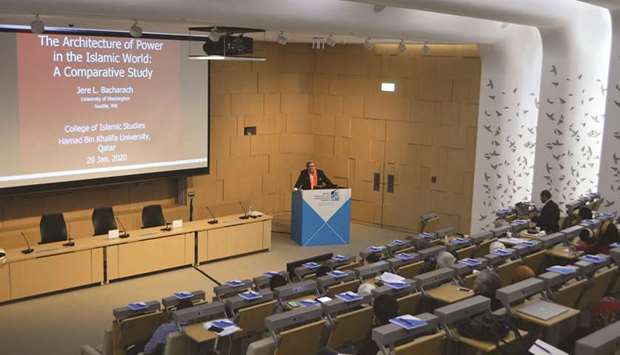Architecture’s enduring contribution to establishment of power throughout the Islamic world was the subject of a recent lecture by the Master of Science in Islamic Art, Architecture and Urbanism (IAAU) programme, College of Islamic Studies (CIS), at Hamad Bin Khalifa University (HBKU).
Led by Dr Jere Bacharach, Professor Emeritus, University of Washington, ‘The Architecture of Power: The Case of the Islamic World: 7th to 21st Centuries’ identified five historical periods that demonstrate the importance of architecture to political power within Islamic countries.
The presentation began with identifying mosques and churches through the appearance of a minaret or a cross, respectively, hence allowing viewers to read architecture. Progressively, trends were noticed by identifying the mosque or dar al-imarah (administrative building) combination, and then followed by the building of palace complexes outside urban capitals. Consideration was given to the emergence of the citadel as a residence for political leaders such as the Fatimid rulers and as the
foundation of the city of al-Qahira.
Dr Bacharach said, “The lecture presents how, over time and in many but not all Muslim lands, one could identify where the ruler’s government was located by ‘reading’ the dominant architectural pattern at that time. One example is studying the citadel – a castle in a Muslim city attached to city walls – from the 12th to the late 19th century. These citadels existed across Spain and India, and typically served as residences for Muslim rulers.”
The fourth period, identified as the “Modern” or “Western” period, presented a gradual move made by Muslim leaders to European parts of capital cities. This was eventually followed by the creation of new capital cities from scratch. Given the broad scope of the subject matter, some notable exceptions to the rule were also highlighted, such as the modern city of Isfahan. Proceedings concluded with a question and answer session as well as additional comments and inputs from the floor.
Speaking after the lecture, Dr M Tarek Swelim, associate professor and programme co-ordinator for the IAAU programme at CIS, said, “While we are a home for contemporary Islamic studies, it’s nevertheless important we consider how the past influences the present. This event traced architecture’s complex and context-specific contribution to the evolution of political power across the Islamic world.”

The lecture identified five historical periods that demonstrate the importance of architecture to political power.


